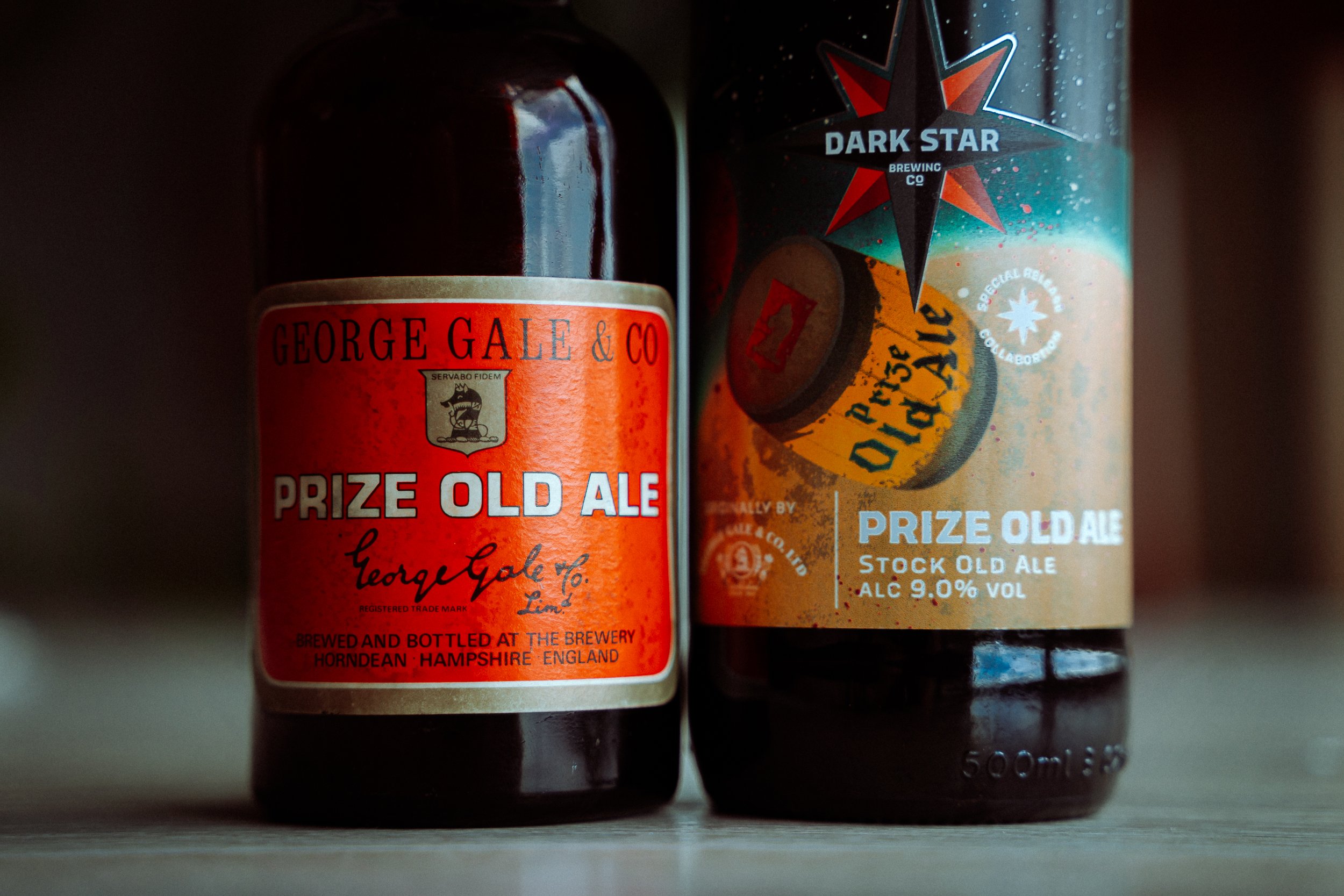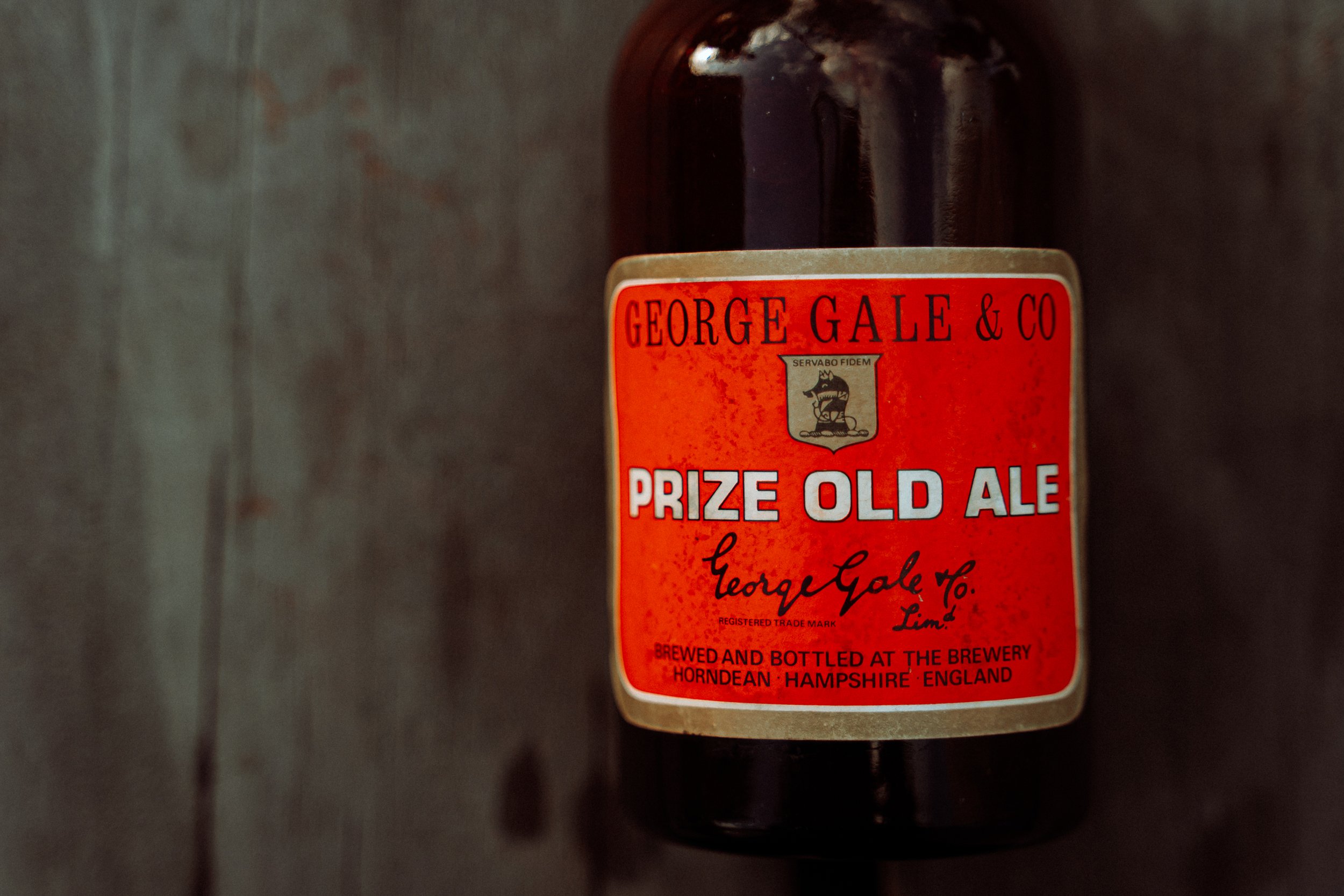The beer in the jug is a deep, deep brown, so dark it is almost black. Half of it was brewed only two months ago; the other half is a melange of different brewings, in three different breweries, with a lineage going back exactly 100 years. Brewer Sven Hartmann pours some into a glass for me, and I sniff and sip. There is umami and liquorice and toffee and toast, a deep complexity, and yet at the same time a sense of youth: a potential that has yet to be fully realized. This is a fine, drinkable beer right now, but a beer that shows every sign that it will mature into something truly magnificent, I suggest to Sven. He nods in agreement.
I’m standing in the tasting room at Meantime Brewing Company in Greenwich, southeast London, drinking the latest iteration of Gales Prize Old Ale, an almost unique survivor from Britain’s brewing past. Set to be released on November 16, this new edition is just about the only U.K. beer made in what Spanish sherry producers call the “solera style,” where a fresh batch is added each year to a vat containing the remnants of editions from previous years. This process means uncounted generations of Brettanomyces, Lactobacillus, and other yeasts and organisms survive and thrive to add fresh depth—and strength—to a beer that is powerful enough at the outset. Prize Old Ale goes into the vat around 9% ABV. A couple of years later, it can come out at 11%.
“I remember opening up the sample tank, and this beautiful, russet-colored beer came out, smelling a bit like Rodenbach Grand Cru, and it tasted just incredible. ”
It was first brewed in 1923 at Gales Brewery in the village of Horndean, Hampshire, eight miles north of Portsmouth, on the southern coast of England. At the time, it was an innovation—or rather, a return to the past—by the firm’s new head brewer, William Barton Mears Jr., aged 31. (Although he has often been misidentified as a Yorkshireman—he was hired from Hepworth’s Brewery in Ripon, Yorkshire—Mears was born in Wolverhampton in the West Midlands.) The kind of strong, dark, long-aged ale he made for Gales had been brewed by many British brewers before World War I. They look to be the beers that inspired Eugene Rodenbach, after he worked in a brewery near London in the 1870s, to go back to Belgium and develop the strong, vat-aged stock ale known in Flemish as “Oude Bruin,” meaning “Old Brown.” A writer in 1920 described aged old ales as “The liqueur of the working man … a delightful substitute for port wine.” Restrictions on brewing strong ales had been imposed during the war, but were removed in 1921.
Mears stayed as head brewer at Horndean for more than 30 years, retiring in 1954. After his departure, Gales continued brewing the beer, which had been known as Prize Old Ale since the late 1920s. The beer began with a mix of pale malt, black malt, and torrefied wheat mashed in a 140-barrel cast-iron mash tun. The resultant wort was then boiled for two hours with Worcester Fuggles and East Kent Goldings hops in an old copper used only for Prize Old Ale, high up in Gales’ classic tower brewery. It was so old, in fact, that boiling wort would run out from between its riveted copper plates and drip down into the brewery below.
The long boil produced caramelization and darkened the wort, which was fermented in wooden vessels and then matured for six months to a year in a washback constructed from New Zealand kauri pine. Over the decades, it became home to multiple colonies of yeast and bacteria that fed on the remaining sugars in the beer, adding flavors and aromas. The ale was then hand-bottled with a small amount of yeast left in each bottle, hand-corked, and hand-labeled in a small outbuilding at the brewery.
In “The Brewmaster’s Table,” Garrett Oliver describes the Prize Old Ale of 2003 as a throwback that George Gale himself would still recognize.
“It pours dark brown with a thin collar of foam. The aroma is dark and complex: Madeira, sherry, malt, rum, kola nut, plum pudding, leather, wool, and wildflowers. Austere, hard hops step in, to balance out the malt, keeping it dry and racy through the center. Connoisseurs prize this beer for its juicy acidity and stunning complexity. It’s beautiful with short ribs, beef cheeks, hanger steak, venison, Manchego cheese, and good ripe farmhouse cheddar.”
Just two years later, however, Gales was bought by Fuller, Smith & Turner. The original Horndean brewery closed in 2006, and production of Gales beers transferred to Fuller’s Brewery in Chiswick, West London. But John Keeling, brewing director at Fuller’s, was determined to see that Prize Old Ale was one of the beers that survived the move. The kauri pine vats, which gave so much character to the brew, could not be moved, so before the Horndean brewery closed, Keeling got the staff there to brew much more Prize Old Ale than they needed for the annual release, some 80 barrels in total. Another 80 barrels were then brewed at Fuller’s in Chiswick, with the help of Gales head brewer Derek Lowe. Twenty barrels of the Chiswick brew were then swapped with 20 barrels of the Horndean brew, so that the yeasts and bugs from the kauri pine vats in Hampshire would inoculate the beer made 50 miles away in West London.
The Fuller’s version of Prize Old Ale was mostly very well received by those who drank it. Unfortunately, Keeling says, it found no love among the Fuller’s sales team, who all hated the beer and wanted him to ditch it. Only two batches were made at Chiswick, the last in 2009, and Keeling hid the remaining 50 or so hectoliters (about 42 Bbl) away in the Fuller’s tank room. There it sat for five or so years until a new recruit to the Chiswick brewing team, Henry Kirk, learned about its existence and decided to sample it.
“I remember opening up the sample tank, and this beautiful, russet-colored beer came out, smelling a bit like Rodenbach Grand Cru, and it tasted just incredible,” Kirk says. “This amazing beer was just lying down in the tank room, neglected, so that started my campaign with Fuller’s to get it released.”
In early 2019, Fuller’s was acquired by the Japanese brewer Asahi, and in November that year Kirk took up the post of head brewer at the Dark Star brewery in Partridge Green, Sussex, which Fuller’s had bought in 2018. His efforts to see Prize Old Ale brewed again took a big step forward when he managed to get a tanker of the beer moved from Fuller’s to Partridge Green, where he then kept it in one of Dark Star’s fermenting vessels at 54º Fahrenheit. By this time, it had risen to 11% ABV and was tasting like a subtle version of Rodenbach Grand Cru. “There is the acetic there, but it’s very soft compared to the Grand Cru,” Kirk says.
The beer sat in Sussex for another two years before Kirk could brew a new batch to mix in with it. “COVID put a block on everything, and I was also terrifying Asahi by insisting that I wanted to have a wooden washback for this beer,” he says. Much of the delay had to do with the cost of the new wooden vessel: some £15,000, or about $18,000. “That derailed the project for about two years, to be honest. But once everyone had calmed down, they said okay, and we brewed it, and mixed the old and the new, and we filled thirty-six hundred bottles, and sold out every time we put a new batch of bottles up, and Asahi went: ‘Hmm.’”
Working from a 1989 brewing book from Gales, Kirk put together a recipe that was 73% English pale malt, 17% invert sugar, 8% percent torrefied wheat, and 2% black malt, with Fuggles and Goldings hops at the beginning and end. Kirk praises that beer’s Maris Otter pale malt, saying, “It imparts a wonderful bready flavor to the beer.” The only invert sugar Kirk and his team could get was the paler No. 1, though he says he would have preferred the darker No. 3 for the extra color and added complexity of flavor. Even so, the beer was dark enough, with 55 pounds of black malt in the mix, that Dark Star’s Anton Paar alcohol meter could not get a gravity reading.
However, just weeks after the first new batch of Prize Old Ale in 13 years was released, Asahi announced that Dark Star would be closing, with production of all its beers transferred to Meantime Brewing Company, which the Japanese firm had acquired in 2016.
The 2022 version of Prize Old Ale was a commercial success, the fastest-selling beer Dark Star had ever released, and Asahi was happy to order another edition for 2023. Sven Hartmann, who had been put in charge of brewing the Dark Star brands at Meantime, found himself having to work out how to make a beer unlike anything else he had ever produced.
“I had been told that the Gales yeast can have a slightly lower attenuation compared to most other yeasts, but it attenuated perfectly—and while the fermentation wasn’t fast, it finished in a decent number of days.”
Hartmann, 30, was born in South Africa, had taken a degree in biotechnology, but fell in love with craft beer and the science behind it after stumbling across a craft beer festival and becoming hooked. He worked for a year and a half with the Jack Black Brewing Company in Diep River, Cape Town, before coming to Britain with his wife in 2017 and getting a job at Meantime. He wasn’t aware of Prize Old Ale until the news broke that production of Dark Star beers was moving to Greenwich, and he first tasted it early in 2023. He was immediately struck by the depth of different flavors in the beer.
There were some doubts about bringing wild yeasts into a brewery that makes only clean beers, using just two strains of yeast. But strict, regimented safeguards were put in place, and the Meantime team did everything in their power to avoid any possible contamination.
“It was a very stressful process,” Hartmann says.
Another 50 hectoliters of Prize Old Ale were brewed at Meantime, and the old and new versions were blended together in a 100-hectoliter tank when the new batch had finished fermenting.
The base malt this time was a “regular” English pale malt, rather than the more expensive Maris Otter, and the hops once again Goldings and Fuggles. The yeast was the same Gales yeast as had been used at Dark Star, sourced from Fuller’s, which still uses it to brew Gales beers at Chiswick. This time, Sven managed to get hold of some No. 2 invert sugar.
“That should give more pear-drop flavors, more toffee-caramel flavors, and make it slightly darker,” he says. “That was a product I had never worked with before. But it went very smoothly, to be honest. It came out to the right sugar spec, the right O.G., and very close to the ABV we wanted as well.”
However, the Gales yeast was somewhat difficult to work with.
“It took some time to drop out, and it definitely gave some high esters throughout the fermentation, banana-y flavors, though that eventually went away towards the end,” he says. “I had been told that the Gales yeast can have a slightly lower attenuation compared to most other yeasts, but it attenuated perfectly—and while the fermentation wasn’t fast, it finished in a decent number of days.”
The fresh batch was brewed in July, the old beer arrived in August, and the two were married together straightaway. The new blend coming out this month will thus have had around three months of maturation. Around 30 or 40 hectoliters will be bottled in 500ml bottles, the same as last year, which will be sold only through the Dark Star website, beginning on November 16. A few days later, limited amounts will start to show up on draft in a few selected U.K. pubs, including the Harp in Covent Garden, Ye Olde Mitre in Holborn, and the Duke of Wellington in Shoreham-by-Sea.
Those who have been connected with the Prize Old Ale project down the decades, naturally, are delighted at the re-re-rebrew. Keeling, probably the man who has done the most to keep the 100-year-old survivor alive, retired from brewing at Fuller’s in 2018. He describes the survival of Prize Old Ale as another reason to be positive about the world of beer.
“I was really pleased with Henry’s version of Prize Old Ale, and I’m looking forward to tasting the latest version,” he says. “The history behind this beer is immense.”
Anthony Smith holds the unique record of having helped brew Prize Old Ale at four different breweries. Now 43, Smith originally joined Gales as quality control manager and brewer in 2004. He was involved with brewing “POA” at Horndean, and again at Fuller’s in Chiswick, where he moved after the closure of Gales and is still employed. At Dark Star, Smith helped Henry Kirk brew the beer before joining Sven Hartmann at Meantime on the latest edition.
“It is really a unique beer in U.K. beer history and a long way away from what you may think a traditional U.K. strong ale is.”
“You definitely need to adjust your drinking habits when tackling this beer,” he says. “POA is an extremely complex beer that involves savoring and appreciating slowly in a different way to most beer styles.”
Now running his own project, Sunken Knave, Henry Kirk says that the beer compares favorably to Belgium’s Flemish Reds and Oud Bruins.
“The vinous, bittersweet complexity that you get from beer that has been matured this long, blended with fresh beer, is captivating to me,” he says. “It is really a unique beer in U.K. beer history and a long way away from what you may think a traditional U.K. strong ale is. My dream is that beers like POA help people re-evaluate classic British styles as something truly to be rediscovered.”
The brewing of Prize Old Ale in Greenwich has also thrilled Meantime founder Alastair Hook. Prize Old Ale, he says, was one of the beers that originally inspired him to become a brewer, aged just 18, after he found a pub in Brighton selling it on draft from a small wooden cask behind the bar. At the time, its raisiny, almondy, treacly flavors seemed less like a beer and more like a slice of a traditional Scottish tea-shop treat.
“It was an inspirational and unforgettable experience,” he says. “I remember it tasting of liquid Dundee cake.”





















